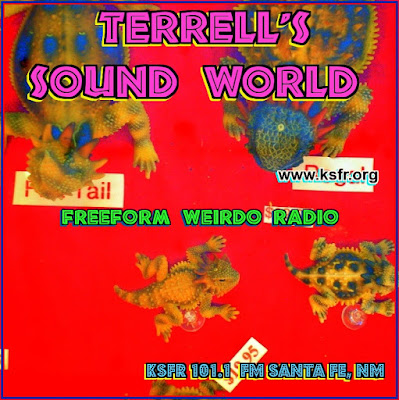One thing that most serious musicians hate is when people try to pigeonhole music into neat categories. It’s true that all these genres and subgenres are mainly for the benefit of marketers -- not to mention being a shorthand for lazy critics or a framework for academic types.
It’s truly refreshing therefore to hear a work of music that scrambles all sorts of disparate styles and genres into a seamless whole. Such is the case of Mylab, the musical brainchild of Seattle musicians Tucker Martine and Wayne Horvitz, If I owned a record store, I wouldn’t be able to decide whether this mostly instrumental CD should be filed under jazz, trip hop, funk, avant garde or worldbeat. And even if I settled on one of those, how would you explain the pronounced bluegrass element, those eerie fiddles and banjos on several of the tracks?
Martine, who has mainly earned his reputation as a recording engineer, and keyboardist Horvitz, started the music that would become Mylab by sampling and looping musty, crusty old folk recordings from the early 1900s. The duo, aided by a gaggle of Seattle musicians -- including guitarist Bill Frisell, Bad Livers banjo madman Danny Barnes (who also plays dobro on some cuts) and singer Robin Holcomb (Horvitz’s missus) -- fleshed out the sound. Unlike projects like, say Moby’s Play, where the folk stuff was at the forefront, by the time the Mylab duo finished, most of the old samples had been replaced by the work of living musicians or altered beyond recognition.
The album starts off with “Pop Client,” a funky little number with James Brown-style horn riffs, mad-scientist piano and what sounds like an upright bass.
On the next track, the music sounds like it’s coming from some third world street. The song’s called “Master Korean Musicians of Canada,” but the guitar loop suggests some lost strain of African music.
The next song, “Land Trust Picnic” starts of with what could be a ‘60s garage-band lick. Then a church organ comes in, which turns jazzy. Then comes Barnes on banjo, as if to let everyone know that this picnic is in the country.
The grass turns even bluer on “Varmit,” which is based upon a spooky fiddle riff (Orville Johnson) backed by Barnes’ dobro and some creepy ooo-ooo-whos by Barnes and Holcomb. The sinister atmosphere is sealed by the lunatic-is-in-my-head laughter in the background.
Mylab never lets up. There‘s tracks like “Earthbound,” built around a monotonously repetitive bass line, with crime-jazz saxes playing off otherworldly electronic effects; the vaguely African-sounding “Phil and Jerry“; the intense “Not in My House” that somehow mutates from guitar-trumpet interplay into drums and electonic rumbling; the sax, synth and percussion madness of “Ask Mickey.”
The wonder of Mylab is that it never becomes predictable.
Also Recommended:
*The Driver is Dead by Ai Phoenix. What was I saying a couple of weeks ago about my newfound love of European art rock? The good people of Scandinavia have been enjoying this low and slow CD by this band from Norway for three or four years but it only got released here a few months ago. Sometimes good things just take time.
Don’t get this mixed up with the high-energy 21st Century punk rock of their Swedish cousins, The Hives. What we have here is smoky, narcoleptic guitar rock with sweet melodies and foreboding undertones.
When sandy-throated singer Mona Mork gets breathy, Ai Phoenix sounds like The Red House Painters fronted by Claudine Longet. I also hear echoes of Mazzy Star (that psychedelic organ, which won’t let go of your ears), Lisa Germano, and even a stripped-down Polyphonic Spree (add about 20 singers, a French horn and some robes and “This is Close” could pass for a Spree melody).
All in all, this is fine dark-night-of-the-soul music. I hope some more recent Ai Phoenix music finds its way to these shores.
*Angel of the Squared Circle by Pedal Steel Transmission. Fans of Wilco and fans of the Mexi-noir sounds of Calexico should give a listen to this Chicago band.
Despite the name of the group, it’s not the steel, but the good old fashioned electric guitar that’s in the forefront of this album. An excellent overview of the PST sound is in the opening 10-minute song “Waiting.” It starts out as a slow tango, but builds up into pure guitar rage.
Some songs are fairly close to country, such as “Amy” (no, not the Pure Prairie League hit), which features prominent pedal steel and Buffalo Springfield guitar licks.
But the best songs are bittersweet and surreal, such as “I Saved the Last High Style for You,” a dreamlike, minor-key melody that is built around a one-finger piano riff. This is followed by a lo-fi piano-based instrumental called “In Mourning,” which sounds as sad as its title.
My favorite tunes here tend to be the long, drawn out jams like the 6-minute“Editene,” which, with its hallucinogenic organ, shows PST could play on the same bill with Ai Phoenix or Wilco; and the shambling ending track, “Baionette.” Try to listen to the first five or six minutes of that one and not think of The Velvet Underground’s “Sweet Nothings” -- though it builds up to a screaming crescendo.



